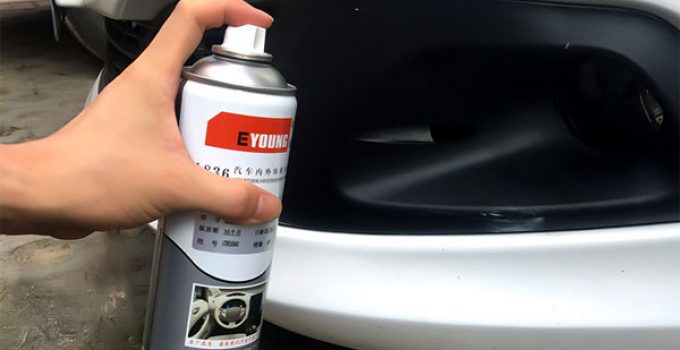Once upon a time, people needed to identify the type of plastic they were working on and make paint suitable for it.
But nowadays, all sorts of plastic paint can be applied to any plastic-type, and it doesn’t even matter if they’re thermoset, thermoplastic, or any other type of plastic. Identifying it isn’t necessary anymore.
And now it’s not even necessary for people to go to workshops to have their plastic bumpers painted. You can learn how to paint plastic bumpers like a pro in just a few simple steps. However, make sure you don’t have any sticker on your bumper.If you have, remove it first! Now, let’s learn those steps.
Steps to Paint Plastic Bumpers
Painting plastic bumpers are simple but a time-consuming process. It needs patience and care if you want the results to be the same as that of professionals. Below are given some steps for you to follow to accomplish a finely painted plastic bumper:
Step 1: Masking
Before anything else starts in this process, you need to prepare your bumper for the work you’ll do on it. You need to mask your car so that nothing happens to the remaining of the chassis when you’re working on your bumper. Some people use newspaper, others use the painter’s tape.
An alternative to masking is to just remove your bumper carefully from your car and set it aside on the ground. This way, you can work on it freely.
Step 2: Sanding
Now that you have your bumper ready, the first task you need to perform before you move on to the painting steps is the sanding of the plastic bumper. The sanding is needed to create friction from heat so that the plastic becomes somewhat of a heat sink since it absorbs heat and softens.
For this, you can use an orbit sander that has a dual-action. Because of sanding, the surface area doubles and makes it possible for fresh coating to stick over the old coating in the most effective way. Even if you do some scuff sanding by hand, it still provides a better result when you paint.
Another advantage of sanding before painting is that it provides more clean areas to paint on and more places for the paint to cling onto. However, if you sand too much, the plastic might split and melt and have thin lines that look like hair strands. If that happens then, any coat of paint will follow those lines and keep the “hairing” visible.
The same goes for heavy power sanding. In this case, when you’re done sanding, you’ll see very visible and obvious scratches, but after a while, it flattens out. This happens because the overdoing of power sanding made the heat friction increase so much that it melted the plastic flat again.
Another disadvantage of over-sanding is the release of mold on the plastic. Although there are many mold release agents, you can find in shops nowadays. The good thing about these mole release agents now is that they are water-based and not wax-based.
Step 3: Cleansing
The next step is to clean the bumpers after the sanding is over. Some manufacturers or professionals have their own automated washers that cleanse the parts with hot water and a special detergent. The professional wash booth even blow-dries the part so that it removes both water and any dirt on the parts.
Along with the detergent wash, there’s a special paste that some car workshops like to use to help abrade the plastic.
When choosing a wax or grease remover, you can either choose cleaners between solvent-based or alcohol-based. Usually, traditional wax or grease removers are solvent-based cleaners, and this solvent gets absorbed into the plastic quickly.
On the other hand, the alcohol-based wax or grease removers don’t get absorbed into the plastic. Instead, they flash off. In theory, one would choose the alcohol-based one. But it seems professionals or leading manufacturers suggest to not use the alcohol ones because they flash off and barely do any cleaning.
These professionals recommend the solvent-based cleaners despite them getting absorbed. So, the best thing to do when using the solvent one is to wipe quickly before the absorption starts.
Step 4: Using Plastic Adhesion Promoters
The need for plastic adhesion promoters is agreed upon by many. These promoters help open the pores on the plastic so that applying coats of paint becomes easier since it’ll adhere to the plastic surface faster.
But adhesion promoters have problems too. These have a short time window for adhesion. You need to act quickly and paint the bumper within a limited time. If you can’t accomplish the work in that opening, the adhesion promoters won’t work properly.
And the solvents in adhesion promoters are very strong and rich, but it won’t help with adhering if it’s used over already painted or primed parts. This is how a person misuses the plastic adhesion promoters. These solvents are used only for raw or bare plastic, and that very plastic must be sanded and clean.
Step 5: Using Primer
An important detail you need to know before painting is whether or not the plastic bumper has a primer on it already. Most people just sand the part to see if any primer dust falls off, but it doesn’t always work that way. Sometimes sanding won’t reveal whether the bumper is primed or not, especially if the color is matte.
Thankfully some manufacturers send details or instructions in their packaging when they send their bumpers, and most manufacturers send unprimed plastic bumpers.
If you want to choose a good primer, you should go for a water-based primer since water doesn’t easily get absorbed by the plastic. Popular manufacturers prefer water-based primers as well.
So in this step, you need to dampen a rag with an enamel reducer and wipe it on the bumper to see how the primer reacts. Check for signs of the primer being resistant, solvent, and adhering. You must do this step carefully because a wet rag full of enamel reducer could wipe off the water-based primer on the part.
And if something feels off about the primer on the part, it’s best if you wipe it all off, re-sand the plastic, and then prime it all over again. This is better than having to remove the primer, redo the priming, strip and then paint again. It becomes a lengthier process that way.
Step 6: Using Flex Additives
Flex additives are also known as elastomeric coatings. These help to keep the paint in place or intact and prevents cracking of chipping of the plastic bumper due to collision with anything.
Step 7: Painting
Now that we’re done preparing the bumper, you can go ahead and paint it. You can either use a spray gun or a spray can for painting. Hold the spray machine 12 inches away from the bumper and apply the paint steadily. Use slow sweeping motions and overlap as you pass so that the paint coats on the bumper evenly.
Remember to put on a mask and goggles before you’re spraying. And while you’re spraying, remember to clean the nozzle every now and then so that the paint doesn’t build up in the nozzle and block the path for the paint to get through. Once you’ve layered your base coat, you can let it dry.
Step 8: Drying
Never try to force dry it. Force drying paint on a plastic bumper is a disaster waiting to happen. When you’re force drying, you’re usually increasing heat to speed up the drying process. This won’t help the paint adhere at all; instead, the paint will melt. Not to mention the material itself is plastic, and that could melt too.
Let the bumper dry in normal heat. Even if it’s a slow process, letting the paint sit and dry for 30 minutes is the safest way to handle this.
After the base layer dries, sand it with a 1500 grit sandpaper by hand. This is how you get rid of paint drips or uneven surfaces where the paint is lumped in an area. It’s better to do wet sanding instead of dry sanding.
Dry sanding could scrape off paint, but wet sanding includes sanding with water on the bumper so it will keep the sandpaper moist and won’t scratch the plastic bumper’s paint job.
And after you’re done sanding and evening the flaws out, add another coat of paint. Repeat the sanding and painting process for as many coats needed for your bumper. And always check to see you have full coverage. After all, coats are complete, you need to let it dry for at least 6 hours before it’s ready to be attached to your car again.
Final Words
Some people also prefer their faded bumpers restored , it also has some distinct processes.However, hopefully the steps above will help you get a good idea of how to paint plastic bumpers by yourself in your own driveway or garage.
You don’t have to worry about having to call people over or having to take your car to a workshop. Because who knows how long they’ll take to finish since they usually have lots of other clients’ cars being worked on.
So why not do it yourself; you’ll be more careful since you’re the owner. You’ll save more costs on the materials needed, especially since you wouldn’t waste anything either.
And best of all, you get to paint your bumper just the way you like it. Once you see how satisfying your work is, you won’t regret learning these steps that helped you through it. Lastly, if you want to keep your existing paint but your paint has chipped off a bit , you can try the paint chip repair kits.



